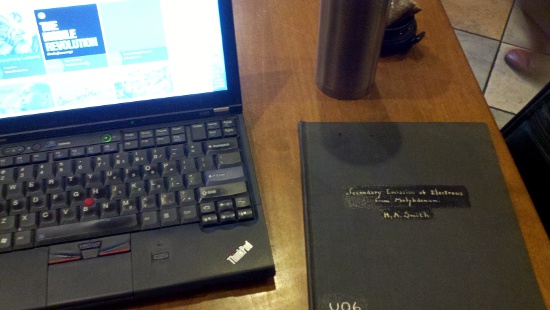Two papers with a similar theme crossed my social media feeds in the last couple of days. You might think this is just a weird coincidence, but I’m choosing to take it as a sign to write about them for the blog. So, what are these papers, and what’s the theme? One is the final… Continue reading One, Two, Many, Lots: Investigating the Start of Many-Body Physics
Category: Atoms and Molecules
Old Thesis Club: The Hyperfine Structure and Zeeman Effect for Mercury Resonance Line 2536.52A by Leo Wilson Scott, 1932
Having spent a bunch of time talking about heavy stuff in the science blogging community, let’s unwind a bit and kick the week off with a look back at an old Master’s thesis. This one is from 1932, and is almost certainly a draft copy, because it’s extremely cheaply bound in cardboard with the title… Continue reading Old Thesis Club: The Hyperfine Structure and Zeeman Effect for Mercury Resonance Line 2536.52A by Leo Wilson Scott, 1932
Old Thesis Club: Secondary Emission of Electrons from Molybdenum, by H.A. Smith, 1928
As noted in a previous post on Monte Carlo simulation in 1960, we recently came into possession of a large box of old Master’s theses. The bulk of these are from the 50’s and 60’s, but there are some going back much farther. As I pass these every day I’m in the office, I thought… Continue reading Old Thesis Club: Secondary Emission of Electrons from Molybdenum, by H.A. Smith, 1928
When Is a Composite Object a Particle?
Through some kind of weird synchronicity, the title question came up twice yesterday, once in a comment to my TED@NYC talk post, and the second time on Twitter, in a conversation with a person whose account is protected, thus rendering it un-link-able. Trust me. The question is one of those things that you don’t necessarily… Continue reading When Is a Composite Object a Particle?
Quantum Crosswords: My TED@NYC Talk
The following is the approximate text of the talk I gave at TED@NYC last night. Approximate, because I’m somewhat prone to ad-libbing when speaking, and may have changed a few things here and there. I don’t really know, because I’m scheduling this post on Tuesday morning, before the actual event, using the draft text I’ve… Continue reading Quantum Crosswords: My TED@NYC Talk
Things I’ve Never Quite Understood: Microscopic Picture of Blackbody Radiation
I’m putting together slides for a TED audition talk in a couple of weeks, about how the history of quantum mechanics is like a crossword puzzle. This involves talking about black-body radiation, which is the problem that kicked off QM– to explain the spectrum of light emitted by hot objects, Max Planck had to resort… Continue reading Things I’ve Never Quite Understood: Microscopic Picture of Blackbody Radiation
Laser-Cooled Atoms: Ytterbium
Element: Ytterbium (Yb) Atomic Number: 70 Mass: Seven “stable” isotopes, from 168 to 176 amu. Two of those are nominally radioactive, with half-lives vastly in excess of the age of the universe. Laser cooling wavelength: 399 nm and 556 nm. Doppler cooling limit: 690 μK in the UV and 4.4 μK in the green. Chemical… Continue reading Laser-Cooled Atoms: Ytterbium
Fun With Simulated Scattering
Two chapters of the book-in-progress will be devoted to the development of the modern understanding of the atom. One of these is about the Bohr model, which turned 100 this year, but Bohr’s model would not have been possible without an earlier experiment. The actual experiment was done by Ernest Marsden and Hans Geiger, but… Continue reading Fun With Simulated Scattering
Laser-Cooled Atoms: Cesium
Element: Cesium (Cs) Atomic Number: 55 Mass: One stable isotope, mass 133 amu. Laser cooling wavelength: 854nm, but see below. Doppler cooling limit: 125 μK. Chemical classification: Yet another alkali metal, column I of the periodic table. This one isn’t greyish, though! It’s kind of gold color. Still explodes violently in water, though. Other properties… Continue reading Laser-Cooled Atoms: Cesium
Laser-Cooled Atoms: Chromium
Element: Chromium (Cr) Atomic Number: 24 Mass: Four “stable” isotopes between 50 and 54 amu. Chromium-50 is technically radioactive, with a half-life considerably longer than the age of the universe, so… Laser cooling wavelength: 425nm, but see below. Doppler cooling limit: 120 μK. Chemical classification: Transition metal, smack in the middle of the periodic table.… Continue reading Laser-Cooled Atoms: Chromium









